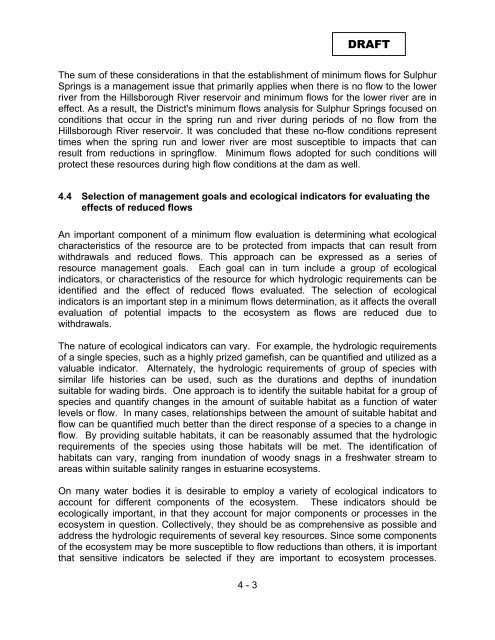The Determination of Minimum Flows for Sulphur Springs, Tampa
The Determination of Minimum Flows for Sulphur Springs, Tampa
The Determination of Minimum Flows for Sulphur Springs, Tampa
You also want an ePaper? Increase the reach of your titles
YUMPU automatically turns print PDFs into web optimized ePapers that Google loves.
DRAFT<br />
<strong>The</strong> sum <strong>of</strong> these considerations in that the establishment <strong>of</strong> minimum flows <strong>for</strong> <strong>Sulphur</strong><br />
<strong>Springs</strong> is a management issue that primarily applies when there is no flow to the lower<br />
river from the Hillsborough River reservoir and minimum flows <strong>for</strong> the lower river are in<br />
effect. As a result, the District's minimum flows analysis <strong>for</strong> <strong>Sulphur</strong> <strong>Springs</strong> focused on<br />
conditions that occur in the spring run and river during periods <strong>of</strong> no flow from the<br />
Hillsborough River reservoir. It was concluded that these no-flow conditions represent<br />
times when the spring run and lower river are most susceptible to impacts that can<br />
result from reductions in springflow. <strong>Minimum</strong> flows adopted <strong>for</strong> such conditions will<br />
protect these resources during high flow conditions at the dam as well.<br />
4.4 Selection <strong>of</strong> management goals and ecological indicators <strong>for</strong> evaluating the<br />
effects <strong>of</strong> reduced flows<br />
An important component <strong>of</strong> a minimum flow evaluation is determining what ecological<br />
characteristics <strong>of</strong> the resource are to be protected from impacts that can result from<br />
withdrawals and reduced flows. This approach can be expressed as a series <strong>of</strong><br />
resource management goals. Each goal can in turn include a group <strong>of</strong> ecological<br />
indicators, or characteristics <strong>of</strong> the resource <strong>for</strong> which hydrologic requirements can be<br />
identified and the effect <strong>of</strong> reduced flows evaluated. <strong>The</strong> selection <strong>of</strong> ecological<br />
indicators is an important step in a minimum flows determination, as it affects the overall<br />
evaluation <strong>of</strong> potential impacts to the ecosystem as flows are reduced due to<br />
withdrawals.<br />
<strong>The</strong> nature <strong>of</strong> ecological indicators can vary. For example, the hydrologic requirements<br />
<strong>of</strong> a single species, such as a highly prized gamefish, can be quantified and utilized as a<br />
valuable indicator. Alternately, the hydrologic requirements <strong>of</strong> group <strong>of</strong> species with<br />
similar life histories can be used, such as the durations and depths <strong>of</strong> inundation<br />
suitable <strong>for</strong> wading birds. One approach is to identify the suitable habitat <strong>for</strong> a group <strong>of</strong><br />
species and quantify changes in the amount <strong>of</strong> suitable habitat as a function <strong>of</strong> water<br />
levels or flow. In many cases, relationships between the amount <strong>of</strong> suitable habitat and<br />
flow can be quantified much better than the direct response <strong>of</strong> a species to a change in<br />
flow. By providing suitable habitats, it can be reasonably assumed that the hydrologic<br />
requirements <strong>of</strong> the species using those habitats will be met. <strong>The</strong> identification <strong>of</strong><br />
habitats can vary, ranging from inundation <strong>of</strong> woody snags in a freshwater stream to<br />
areas within suitable salinity ranges in estuarine ecosystems.<br />
On many water bodies it is desirable to employ a variety <strong>of</strong> ecological indicators to<br />
account <strong>for</strong> different components <strong>of</strong> the ecosystem. <strong>The</strong>se indicators should be<br />
ecologically important, in that they account <strong>for</strong> major components or processes in the<br />
ecosystem in question. Collectively, they should be as comprehensive as possible and<br />
address the hydrologic requirements <strong>of</strong> several key resources. Since some components<br />
<strong>of</strong> the ecosystem may be more susceptible to flow reductions than others, it is important<br />
that sensitive indicators be selected if they are important to ecosystem processes.<br />
4 - 3

















